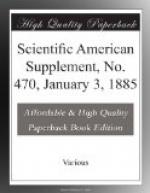* * * * *
NOTES ON NITRIFICATION.[2]
[Footnote 2: A paper by R. Warington, read before the Chemical Section of the British Association at Montreal.]
By R. WARINGTON.
In the following brief notes I propose to consider in the first place the present position of the theory of nitrification, and next to give a short account of the results of some recent experiments conducted in the Rothamsted Laboratory.
The Theory of Nitrification.—The production of nitrates in soils, and in waters contaminated with sewage, are facts thoroughly familiar to chemists. It is also well known that ammonia, and various nitrogenous organic matters, are the materials from which the nitric acid is produced. Till the commencement of 1877 it was generally supposed that this formation of nitrates from ammonia or nitrogenous organic matter was the result of simple oxidation by the atmosphere. In the case of soil it was imagined that the action of the atmosphere was intensified by the condensation of oxygen in the pores of the soil; in the case of waters no such assumption was possible. This theory was most unsatisfactory, as neither solutions of pure ammonia, nor of any of its salts, could be nitrified in the laboratory by simple exposure to air. The assumed condensation of oxygen in the pores of the soil also proved to be a fiction as soon as it was put by Schloesing to the test of experiment.
Early in 1877, two French chemists, Messrs. Schloesing and Muentz, published preliminary experiments showing that nitrification in sewage and in soils is the result of the action of an organized ferment, which occurs abundantly in soils and in most impure waters. This entirely new view of the process of nitrification has been amply confirmed both by the later experiments of Schloesing and Muentz, and by the investigations of other chemists, among which are those by myself conducted in the Rothamsted Laboratory.
The evidence for the ferment theory of nitrification is now very complete. Nitrification in soils and waters is found to be strictly limited to the range of temperature within which the vital activity of living ferments is confined. Thus nitrification proceeds with extreme slowness near the freezing-point, and increases in activity with a rise in temperature till 37 deg. is reached; the action then diminishes, and ceases altogether at 55 deg.. Nitrification is also dependent on the presence of plant-food suitable for organisms of low character. Recent experiments at Rothamsted show that in the absence of phosphates no nitrification will occur. Further proof of the ferment theory is afforded by the fact that antiseptics are fatal to nitrification. In the presence of a small quantity of chloroform, carbon bisulphide, salicylic acid, and apparently also phenol, nitrification entirely ceases. The action of heat is equally




